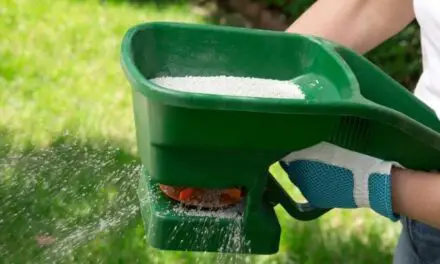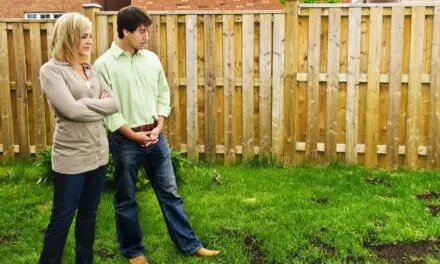A beautiful lawn is something you can really take pride in and enjoy every day from the window of your own home.
But an uneven and patchy lawn just never seems to look right and every time you look at it, that little voice in your head tells you that it’s a job you’re one day going to have to sort out.
Knowing the causes of an uneven lawn is the first step in tackling the problem so let’s look a bit closer.
Table of Contents
Why Does My Lawn Grow Unevenly?

Your lawn is not growing evenly because it’s getting too much water and/or uneven amounts of sunlight.
In both of these cases, the grass is not getting the proper nutrients it needs evenly throughout the entire lawn.
Both disproportionate exposures to water and light will cause grass to grow at different rates, even grass on the same lawn.
Other less common causes of a lawn growing unevenly are different grass and soil types within the same lawn, spreading fertilizer unevenly, compacted soil, and mowing the grass too short.
Let’s dig deeper into each of these issues and learn more about how to fix your uneven lawn.
Most Common Causes For An Uneven Lawn
As mentioned above, the two most common reasons for an uneven lawn are disproportionate exposure to water and sun throughout the lawn.
Let’s look at both of these causes in more detail.
Related Article: What Is Causing Bumps In My Lawn And How Do I Fix It?
Too Much Water
Grass is pretty tough and unlike more traditional plants, it can typically thrive, even when it has been severely overwatered.
Though water is certainly a good thing for lawns, too much of it can make your lawn patchy.
Obviously, water that is disproportionately sprinkled throughout the lawn will cause certain grass areas to grow faster than others.
Probably less obvious is the fact that excessive amounts of water can cause issues concerning drainage.
If your lawn gets a whole lot of water, it likely won’t be able to drain away fast enough.
As a result, depressions will form throughout your lawn, creating a lumpy and swampy mess.
These depressions then create a never-ending cycle of bumpy and uneven lawns.
Since there’s no proper drainage, certain areas continue to grow while others die.
This will make the depressions even worse and the cycle never ends.
If you think that excessive water is to blame for your uneven lawn, try to sort out new drainage or stop watering your lawn as much.
Uneven Sunlight
Another common reason for an uneven lawn is when some areas receive more sunlight than others.
As you probably know, plants absolutely need sunlight to survive and grow.
Grass especially evolved to need a whole lot of sun exposure.
If certain parts of your lawn are shady, that grass may not be growing as quickly.
Uneven distribution of sunlight should be pretty easy to spot.
Just look for shaded areas that are exposed to less sun than others.
This may be beside a tree, fence post, or home.
In some cases, it may be difficult to fix this issue.
For example, if the shade is because of your house, there’s little you can do.
You can try to add more fertilizer to the affected area to help compensate for the lack of sunlight, but this won’t work in all cases.
Related Article: What Is The Point of Grass?
Overexposure to water and uneven distribution of sun are not the only two causes for patchy and uneven lawns.
In fact, it can be difficult to pinpoint the exact reason for uneven grass since a variety of factors can be the root of the problem.
Here are some other reasons why the grass on your lawn may not all grow at the same rate:
Different Types Of Grass
The lawn features different types of grass.
Not all grass has the same growth rate. Only use one type for an even lawn.
Fertilizer
Spreading fertilizer unevenly can cause certain patches to grow faster than others, leading to an uneven yard.
Different Types Of Soil
Just as different grass types can lead to an uneven yard, so too can different soil types.
Different soils will have varying minerals.
Try to coat your lawn with appropriate soil for an even base.
Mowing The Grass Too Short
Cutting your lawn too short prevents the grass from taking in the essential energy and nutrients from the sun and other resources that it needs to grow properly.
In general, you should only be removing about the top one-third of the grass blade each time you mow.
Ideally, you should only mow your lawn when the grass is about 3 2/3 inches tall.
And an optimum height for grass to thrive is usually about 2 1/2 inches.
Compacted Soil
Another common reason
grass may not grow properly is compacted soil.
Many things can cause the soil to become too dense.
A lot of walking on the soil by people or even pets can compact it over time.
Another problem is that the lawn was not properly prepared before turf or grass seed was put down.
If the soil is too clayey it can easily compact and will have very poor drainage.
Before grass is grown, organic matter should be added to the soil.
How Do You Fix Uneven Grass?
One of the most effective ways to fix uneven grass is to apply top-dressing to your lawn.
Top-Dress Your Lawn
You’ll find many effective top-dressing mixes online or at your local garden store.
Compost is also a great choice, but when top-dressing with it, you should only use compost that’s 3/8-inch in size or less.
Screened compost also works great to get in between the blades of grass.
Be careful with compost that comes in larger pieces as it may smother your grass.
Once you found the mix you want to use, add half an inch of top-dressing to your existing grass and spread it out around your lawn using something flat, like the back of a rake.
Keep pushing the soil around until it has worked its way into all the aeration holes and covered any low spots.
Continue working the soil until it is level and the grass is just peeking through.
If you have a dog, their urine can also kill the grass.
If you notice random dead patches in your yard, it may be because of that.
Final Thoughts
Uneven lawns are definitely not the nicest to look at, but they aren’t impossible to fix.
In most cases, excessive amounts of water and uneven exposure to sunlight are the main reasons.
Simply add better drainage or use extra fertilizer in shady areas.
An uneven lawn can also be caused by different types of soil, grass, and from cutting your lawn too short.




